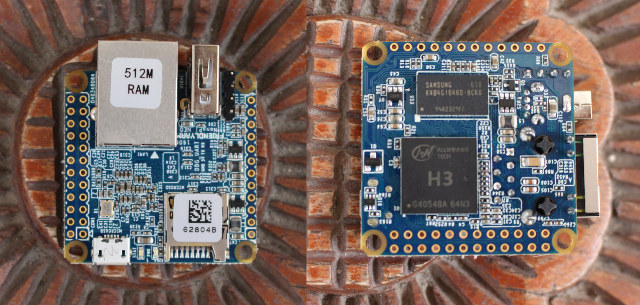We’ve been blessed with a wide range of low cost Allwinner H3 boards thanks to Shenzhen Xunlong Orange Pi and FriendylARM NanoPi boards. Recently, armbian developers have been focusing on NanoPi NEO board, and they’ve now released Debian Jessie and Ubuntu Xenial with Linux 4.6.7 and Linux 4.7.2. The latter is mainline kernel with some patchsets for Ethernet.
 You can download the Linux 4.6.7 based “beta” images from armbian NanoPi NEO page, and selected the “Vanilla” versions, then flash then one a micro SD card as you would normally do. Linux 4.7.2 based “experimental” images with USB OTG support and schedutil cpufreq governor can be found on the separate server in a temporary directory.
You can download the Linux 4.6.7 based “beta” images from armbian NanoPi NEO page, and selected the “Vanilla” versions, then flash then one a micro SD card as you would normally do. Linux 4.7.2 based “experimental” images with USB OTG support and schedutil cpufreq governor can be found on the separate server in a temporary directory.
Thomas Kaiser explains further:
Ethernet and throttling are working (the latter not as efficient as with legacy kernel but at least it protects the SoC from overheating). Please note that all vanilla kernel images currently suffer from random MAC addresses on reboot so better choose a static IP address configuration. Also keep in mind that current cpufreq scaling settings in mainline kernel don’t know the 912 MHz operating point so with our default /etc/defaults/cpufrequtils contents you end up with 816 MHz max cpufreq (feel free to adjust, throttling works with these images).
You can test the schedutil cpufreq governor in Linux 4.7, by changing /etc/default/cpufrequtils to something like:
|
1 2 3 4 |
ENABLE=true MIN_SPEED=240000 MAX_SPEED=1200000 GOVERNOR=schedutil |
They have not released equivalent “Vanilla” images for Allwinner H3 Orange Pi boards, but I guess it will done once NanoPi NEO images are proven to be working reasonably. Eventually, you’ll be able to download the Linux kernel directly from Kernel.org for your Allwinner H3 boards. I’ve been told this won’t happen in Linux 4.8, but I’d assume Linux 4.9 or 4.10 are realistic targets.
Since NanoPi NEO board has been designed for IoT applications with low load too, armbian community has also investigated how to lower power consumption, and after finding that disabling Ethernet PHY saved 200 mW, and disabling HDMI and the GPU 210 mW, they created a new tool (bash script) called h3consumption, and working on all Allwinner H3 boards. You can find more power savings tips and h3consumption options in the forums.

Jean-Luc started CNX Software in 2010 as a part-time endeavor, before quitting his job as a software engineering manager, and starting to write daily news, and reviews full time later in 2011.
Support CNX Software! Donate via cryptocurrencies, become a Patron on Patreon, or purchase goods on Amazon or Aliexpress



